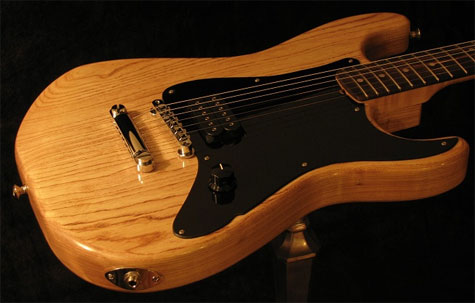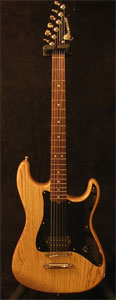More On the YMI5150 Model-A Guitar

A close up but this one is missing the band-pass knob....
Few weeks ago I posted a brief “review” (outdated word) of Kevin Holbrook’s YMI5150 Model-A guitar. As a brief reminder, what got my attention were the following things:
> A good wood combo: swamp ash, maple/rosewood.
> An interesting and unique combo of components resulting in a Strat-shaped and -scaled guitar with an ABR bridge and stop tailpiece with a classic rock pickup (DiMarzio Super Distortion) and old-school brass nut.
> A different type of tone control, in part based on experiments around the question of why EVH had other pots and pickups hooked up in his Frankie guitar, back in the day.
> A good price point.
The guitar played and sounded great, so as part of the process I cornered Kevin for a few questions, which follow.
WoodyTone: What were you shooting for with this?
Kevin: That’s a tough question to answer. When I reflect on how all this went down, it went something like this.
I’d been building [Edward Van Halen] Frankie and 5150 replicas, and there were certain things I liked about one, and certain things I liked about the other. Like I was a big fan of a natural grain-and-oil finish on the necks, single-humbucker simplicity, the Azusa body shape and the MXR knob. Ed’s right that there’s nothing better than a natural-finished neck and the profile of the EVH Music Man neck is the best I’ve played.
But I wanted something of my own, so I started putting together a mutt for myself, and that’s how the general dynamics of the guitar came about. Never had a thought about selling one.
After a few years of building, my focus shifted to chasing tone. I started building old ’68 Marshall plexi replicas with the help and guidance of the guys over at Metro, and there I discovered how difficult accurately replicating early VH tone was going to be.
The guitar and amp work together – along with a lot of other stuff to get the final result – so I focused on the construction of the guitars used for certain recordings.
 Very few used locking tremolos, and I had a lot of guitars with trems. I wanted to try to build a strat-shaped guitar for non-trem songs that had as much ‘oomph’ as a Destroyer – but if you drink the Kool-Aid, the bridge has a lot of influence on tone and trems hog out a bunch of precious wood that I knew I needed to even get close to competing with a large slab guitar. So I threw a stoptail on my original mutt guitar.
Very few used locking tremolos, and I had a lot of guitars with trems. I wanted to try to build a strat-shaped guitar for non-trem songs that had as much ‘oomph’ as a Destroyer – but if you drink the Kool-Aid, the bridge has a lot of influence on tone and trems hog out a bunch of precious wood that I knew I needed to even get close to competing with a large slab guitar. So I threw a stoptail on my original mutt guitar.
Then one day I was staring at a pic of the Bumblebee [Ed’s black/yellow stripes guitar] control cavity and a lightbulb turned on. I believe Ed never did anything by accident, so the extra pot I was seeing was there for a reason. Actually, most of his old axes had tone controls, but things appeared to be wired a bit unusually. I started tinkering and all of the sudden, magic happened.
That pot, some other cool stuff, and the way it’s wired has the ability – when set correctly – to take the edge off DiMarzio Super Distortion and Mighty Mite [DSD clone] pickups.
I started bouncing this off the guys at the Metro boards, trying to understand what the heck was going on. Guys like Good Guest and the late, great Stunt Double labeled it a resonance mod – it focuses specific frequencies that can be adjusted and dialed into the rest of the rig as needed.
Not sure if this is how Ed set his guitars up, but regardless, my ears and the ears of people who play this guitar love what it does for adding versatility to a single-pickup guitar. When you roll this pot back, it really warms [the tone] up, takes a lot of the grind out of it and turns [a DSD] into a PAF-style pickup.
At this point I realized I had something special, something a lot of people would enjoy playing.
Seems like you’re trying to bridge certain EVH tones with this guitar.
I wouldn’t say I’m intentionally combining various era EVH tones together, but I am offering a guitar that is versatile enough to target multiple tones. What I mean is, my philosophy is to design to the toughest requirements and by doing that you will meet all lesser ones.
And in my opinion, the tone of the [Van Halen] club days and the first VH record tone is some of the most elusive, unattainable, coveted tone out there. As you’ve experienced, mess around with it and it falls right in line with old ACDC, Tesla, Scorps, all that.
So are you hoping to appeal to just Ed-heads?
Well, Ed was king and he was really an engineer so I can relate to a lot of what he was doing. But this guitar doesn’t just do Van Halen. It’s a great classic rock guitar, and the cool thing is it has sort of an organic look to it so it’s not flashy. The people I see playing it are people who wear T-shirts and jeans, regular kinds of musicians.
What does that second knob do – the band pass?
It’s a unique tone circuit, but it still is a tone circuit. It’s really an active band-pass filter so you can adjust the sizzle of the pickup, as opposed to the high end frequencies. Full out you get the DSD ceramic-magnet heat, dial it back and it falls into a PAF category. Kinda cool.
I’m curious about the old-school brass nut. Why did you choose that?
Both of Eddie’s guitars around the time of the first record had that material [nut]. Brass will affect the ring of the strings the least – softer material dampens string vibration so I think that’s maybe why he did it. Some call it harsh, but coupled with the electronics, I get maximum sustain and a warm tone.
More
> The Model-A is $1,395 plus shipping. Order it and contact Kevin here.
> The neck profile is asymmetrical, like a Ernie Ball EVH Musicman, which Kevin said is “the most comfortable profile I’ve ever felt.” I’ve played and for sure it is comfortable. The birdseye maple neck has a 10″ radius and the frets are 6105 mediums, standard nickel alloy.
> He spent a lot of time with Scott Smith at Musikraft on the “Azusa”-shaped Strat body. Azusa is the town in southern California where Charvel moved from San Dimas.
> Both pots are 500k.
> The guitar has a side input jack and the pickguard “is really there more for aesthetics,” Kevin said. “I always liked the old Gibson Flying Vs and Explorers that had that sort of honey color with the black pickguard. You can take the pickguard off but it off looks a little too bland for me.”
More: Want
The Model-A really opened my eyes to a few things. One is the DSD – a great pickup that I hadn’t played for way too long.
Second is the comfort of the Strat body shape, especially compared to the vintage Les Paul I’ve been playing. The light weight of the swamp ash is great too, as is the tone.
Third is the ease of playability. The body shape, neck radius and stoptail made the Model-A literally one of the easiest guitars to play I’ve ever experienced – maybe the easiest. My chops aren’t amazing anymore, if they ever were, but I have to say it’s easier to pull just about anything off on that guitar.
If I had to design the WoodyTone Model-A from the ground up, I’d really want to A/B versions with these options, though there isn’t a thing wrong with how Kevin builds the original Model-A:
> Mahogany body with a maple top
> T-Top style pickup but with more output (more sustain)
> Bone nut
Thanks again to Kevin for letting me give it a test drive (vid is below again – the chops might scare you…lol). Hope to own a Model-A one day.
More: Kevin Says….
“I’ve received requests for custom features such as Floyd Roses and a shorter scale length. I’m happy to accommodate requests. Just know that custom orders are subject to price increases that apply, and full payment is required up front due to the fact that those features require one-off production runs. We’re working on updating the website to reflect this new option.”
He noted that custom lead times are about 4-6 weeks. “Once I get components in my hands, my OCD personality takes over and I work around the clock to get things out to you.”
Category: Edward Van Halen, YMI5150














That tone circuit sounds like what Kramer was attempting in the 80’s. If you open up an unmodified Kramer Baretta, the volume pot had a capacitor wired to it with the Duncan JB model pickups. When you rolled the volume down, they added a bit of high end sparkle, when cranked, it was full on, loud, and had more gain. Also, one reason they had the Floyd to the body (probably per Ed) was to get more “grounding” with the wood and more resonance with the body/strings/everything. It all makes a difference. If you can check out an old Baretta, you’ll see this. Not all model Kramers had this capacitor on the volume.
Kevin is a gearheads gearhead. I am fortunate enough to be the first one to have a custom made plexi made by him. It’s custom wired and dialed in to the guitar,pup and cabinet. You won’t be disappointed if you hire him to build something for you.
I just bought the YMI5150 model A prototype. I’ve been wanting a Fender scale stop tail for awhile and I’m actually working on my own custom build. Then I saw that Kevin was selling the prototype model A. I met up with Kevin and checked out the guitar. It is super easy to play and I love the feel, finish, and looks. The tone goes without saying. It is really great to have a local guitar builder with good ideas and an eye for style. This will not be my only Holbrook. Well done Kevin!